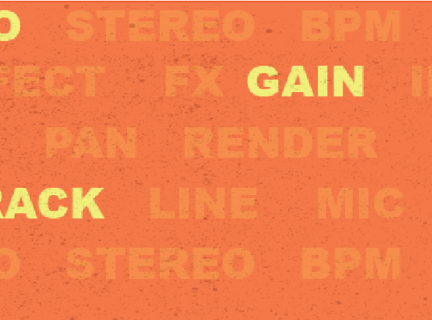REAPER Glossary

Unsure of what that REAPER term means? This guide has a list of terms you might encounter while recording and editing with REAPER. Basic definitions are provided.
Beats Per Minute
Also known as BPM, the Beats Per Minute is the tempo of a song, or how fast or slow a song is. If working with music, it is important to set the beats per minute before importing or recording - this way the metronome tool can be used to help keep time and edit. If you are only recording spoken words, you do not need to worry about changing the BPM.
Compression
This often means data compression but it can also mean dynamic range compression. The two are not related and should not be confused. See each definition for clarification.
Data Compression
How information is coded in a file so that a file's size is made smaller than if had uncompressed information. Compressed audio files are either lossless or lossy. The more compressed the data of a file is, the smaller its file size is. How much smaller the file will be depends on the file format.
Dynamic Range Compression
Unrelated to file size, dynamic range compression means reducing the difference between the peak and average levels of loudness in music. Changing the dynamic range is a way of adjusting audio that is a bit advanced, and there are no instructions in this guide for how to do this. (Dynamic range compression is only mentioned here to clarify that it is not the same thing as data compression, although both of these terms may be referred to simply as "compression". You may come across information about DAWs or mixing audio that just use the term "compression", and you will have to understand from context which definition of compression is meant.)
Effect
Intentional alteration of an audio file or MIDI item. An example of an audio effect is adding reverb. Effects are also referred to as FX.
Export
In REAPER, used in relation to MIDI; exporting MIDI means turning a project with MIDI items into a single MIDI file.
File Format
A way information is encoded. Different software can open different kinds of file formats. Some software create file formats that can be used by many programs, and some by only a single program. WAV and MP3 are examples of file formats.
Gain
The "input volume" of a track. This allows you to modify the relative volumes of different tracks independently of any effects applied to them.
Import
Bringing an audio or MIDI file into a track in a REAPER project. Once a file has been imported, the audio can be manipulated using the program.
Lossless
Data compression than creates a file with a smaller file size than uncompressed (raw) audio, but audio fidelity will be unaffected (or not very affected).
Lossy
Data compression that generally creates a file with a smaller file size than uncompressed or lossless audio, but this is at the expense of audio fidelity. Sometimes this loss of fidelity is not noticeable to most people, especially on computer speakers, but when fidelity is lost it cannot be regained.
MIDI
Unlike recorded audio, MIDI is a series of instructions for a computer to use sound fonts to generate sounds.
Mono
Short for monophonic. Audio with a single track. When played back on a stereo system or on headphones, both the right and left speakers will sound the same.
Pan
The ability to shift the audio on a track between the left (L) and right (R) speakers. A track with audio panned to the left will be heard more in the left speaker or left headphone, and vice versa when panning to the right.
Project
All the tracks with edits and settings currently being worked on are saved as a REAPER *.rpp file.
Record Monitoring
Direct monitoring is when your headphones or speakers receive the exact signal you're inputting to your audio interface. There is no delay and it is unprocessed.
Record monitoring is when you listen to your live signal after it travels through and is processed by the computer/software. This takes into accounts any mixing/effects added to the track. Sometimes there is latency (a delay for the computer to process) which causes a bit of lag which sounds like an echo. Settings can be adjusted to mitigate this, or you can turn record monitoring off to directly monitor from your interface.
Render
Taking tracks in a REAPER project, and creating an audio file.
Split
Breaking up an audio file or existing clip into two (or more) smaller clips. The shortcut in REAPER for this on the keyboard is the letter S.
Stereo
Short for stereophonic. Audio with two tracks: a left (L) track and right (R) track. A stereo file can be placed in a single REAPER track; you will see a top and bottom waveform.
Track
Where an audio file or MIDI item is placed. A REAPER project can have many tracks or just one.
Uncompressed
Raw data. Audio files with uncompressed data will have high audio quality, but these files can be very large.
